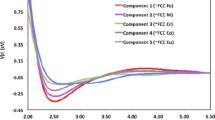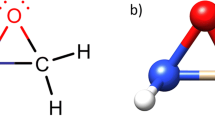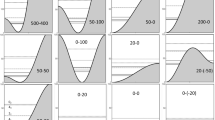Abstract
Using the LCAO MO SCF method in the MNDO valence approximation, we have carried out a systematic study of the electronic and spatial structure of cluster models of the bulk phase and the hydroxylated and chemically modified surface of silica surface. We propose a technique for taking into account the crystallochemical environment of the clusters modeling the bulk phase of SiO2, based on passivation of the abnormal valencies at the boundary of the clusters by hydrogen atoms, the geometrical location of which ensures homogeneity in the electron density distribution on the silicon atoms of the model fragment. We give a comparative analysis of the electronic characteristics of the studied cluster models. We consider the nature of the adsorption centers and the properties of the hydroxylated and modified silica surface.
Similar content being viewed by others
Literature cited
A. P. Zeif, “Application of semiempirical LCAO MO methods to the calculation of cluster models for semiconductors and dielectrics,” in: Elementary Physicochemical Processes on the Surface of Single-Crystal Semiconductors [in Russian], Nauka, Novosibirsk (1975).
G. M. Zhidomirov, A. A. Bagatur'yants, and I. A. Abronin, Applied Quantum Chemistry [in Russian], Khimiya, Moscow (1979).
G. M. Zhidomirov and I. D. Mikheikin, Cluster Approximation in Quantum Chemical Investigations of Chemisorption and Surface Structures [in Russian], VINITI, Moscow (1984). (Results of Science and Technology, Structure of Molecules and the Chemical Bond, Vol. 9).
I. D. Mikheikin, I. A. Abronin, G. M. Zhidomirov, and V. B. Kazansky, “The cluster model calculations of chemisorption and elementary acts of catalytic reactions. 1. Isotopic substitutions of hydrogen atoms of surface OH groups of silica gel,” J. Mol. Catal., 3, No. 2, 435–442 (1977/78).
I. D. Mikheikin, A. I. Lumpov, G. M. Zhidomirov, and V. B. Kazanskii, “Calculations of chemisorption and elementary events of catalytic reactions with the framework of the cluster model. 4. Properties of surface ‘bridge’ OH groups in aluminosilicates and zeolites. Effect of the Si/Al ratio,” Kinet. Katal., 19, No. 4, 1053–1057 (1978).
Yu. I. Gorlov, K. I. Tkachenko, M. M. Konoplya et al., “Study of the electronic structure of fragments of the silica surface on the basis of cluster models,” Absorb. Adsorbenty, No. 6, 50–61 (1978).
B. M. Mitsyuk and L. I. Gorogodskaya, Physicochemical Transformations of Silicas under Metamorphism Conditions [in Russian], Nauk. Dumka, Kiev (1975).
M. S. J. Dewar and W. Thiel, “Ground states of molecules. 38. The MNDO method. Approximations and parameters,” J. Am. Chem. Soc., 99, No. 15, 4899–4907 (1977).
S. S. Batsanov, Electronegativity of Elements and the Chemical Bond [in Russian], Izdat. Sibir. Otd. Kad. Nauk SSSR, Novosibirsk (1962).
G. M. Bartenev, S. M. Brekhovskikh, A. Z. Varisov et al., “The nature of chemical bonds in oxygen-containing glasses from positron annihilation data,” Izv. Akad. Nauk SSSR, Ser. Neorg. Mater., 6, No. 9, 1553–1556 (1970).
S. Yoshiko, M. Tatewaki, and S. Husinaga, “A systematic preparation of a new contracted Gaussian-type orbital set. 6. Ab initio calculation on molecules containing Na through C1,” J. Comput. Chem., No. 1, 108–125 (1981).
E. T. Lippmaa, A. V. Samoson, V. V. Brei, and Yu. I. Gorlov, “Investigation of the structure of highly dispersed silica by high-resolution 29Si and 1H NMR methods in the solid phase,” Dokl. Akad. Nauk SSSR, 259, No. 2, 403–408 (1981).
A. V. Kiselev and V. I. Lygin, Infrared Spectra of Surface Compounds [in Russian], Nauka, Moscow (1972).
J. Sauer, “Molecular structure of orthosilicic acid and importance of (p-d)π bonding. An ah inicio molecular orbital study,” Chem. Phys. Lett., 97, No. 3, 275–278 (1983).
J. B. Peri, “Infrared study of OH and NH2 groups on the surface of dry silica aerogel,” J. Phys. Chem., 70, No. 9, 2937–2945 (1966).
M. M. Konoplya and Yu. I. Gorlov, “Study of reaction of water molecules with activated centers of the silica surface using self-consistent perturbation theory,” Teor. Eksp. Khim., 16, No. 2, 166–173 (1980).
B. N. Laskorin, V. V. Strelko, D. N. Strazhesko, and V. M. Denisov, Sorbents Based on Silica Gel in Radiochemistry [in Russian], Atomizdat, Moscow (1977).
K. Ya. Burshtein and A. N. Isaev, “Modification of the MNDO method for calculation of systems with hydrogen bonds,” Zh. Strukt. Khim., 35, No. 1, 25–30 (1984).
K. Wiberg, “Application of the CNDO method to the cyclopropylcarbynyl and cyclobutyl cation rearrangement and to the cyclobutane,” Tetrahedron, 24, No. 3, 1084–1096 (1968).
A. A. Chuiko, “Chemistry of the SiO2 surface, nature and role of active centers in adsorption and chemisorption processes,” Author's Abstract, Dissertation in competition for the academic degree of Doctor of the Chemical Sciences, Kiev (1971).
Yu. I. Gorlov, “Electronic structure, energetics of formation and properties of adsorption complexes of polar molecules on the surface of silica,” Zh. Fiz. Khim., 59, No. 5, 1213–1218 (1985).
K. V. Gavrilyuk, Yu. I. Gorlov, V. A. Nazarenko, et al., “Mass spectrometric investigation of thermal desorption of water and methanol from the surface of trimethylsilyl aerosil,” Teor. Eksp. Khim., 19, No. 3, 364–367 (1983).
V. V. Brei, “Investigation of adsorption states of some electron-donor molecules on the surface of pyrogenic silcia,” Author's Abstract, Dissertation in competition for the academic degree of Candidate of the Chemical Sciences, Kiev (1982).
E. F. Voronin, “Effect of the nature of the surface functional groups of silica on the process of chemisorption of polar molecules,” Author's Abstract, Dissertation in competition for the academic degree of Candidate of the Chemical Sciences, Kiev (1981).
Yu. V. Fedorovich, “Electron-ion processes in the semiconductor-dielectric system,” in: Elementary Physicochemical Processes on the Surface of Single-Crystal Semiconductors [in Russian], Nauka, Novosibirsk (1975), pp. 137–149.
H. P. Phillip, “Optical transitions in crystalline and fused quartz,” Solid State Communs., 4, No. 1, 73–76 (1966).
K. Evrard and A. N. Trukhin, “Photoelectric properties and the energy gap of SiO2,” Phys. Rev. B, 25, No. 6, 4102–4105 (1982).
Author information
Authors and Affiliations
Additional information
Translated from Teoreticheskaya i Éxperimental'naya.Khimiya, Vol. 22, No. 5, pp. 533–545, September–October, 1986.
Rights and permissions
About this article
Cite this article
Gorlov, Y.I., Zaets, V.A. & Chuiko, A.A. Investigation of the electronic structure and properties of cluster models of silica by the MNDQ method. Theor Exp Chem 22, 509–520 (1987). https://doi.org/10.1007/BF00522535
Received:
Issue Date:
DOI: https://doi.org/10.1007/BF00522535




